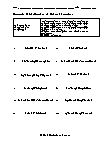Multiplying Rational Fractions Worksheets
How to Multiply Rational Fractions A rational expression is a ratio of two polynomials. The domain of a rational expression includes all real numbers except those that make its denominator equal to zero. We can simplify rational expressions by cancelling common factors in the numerator and the denominator. To start, let's recall how to multiply numerical fractions. Consider this example: (3x2 / 2) . (2 / 9x). We can multiply rational expressions in much the same way as we multiply numerical fractions. = {(3 . x . x) / 2} . {2 / (3 . 3 . x) - Factor numerators and denominators. Using cross multiplication: X / 3. Recall that the original expression is defined for x (not equal to) 0, does not equal, 0. The simplified product must have the same restrictions. Because of this, we must note that x(not equal to) 0. In conclusion, to multiply two numerical fractions, we factored, cancelled common factors, and multiplied across.
-
Basic Lesson
Demonstrates general rules of multiplying rational fractions. The rule for multiplying rational fractions is same as that of numerical fractions i.e. multiplying the numerator with numerator and denominator with denominator.
View worksheet -
Independent Practice 1
Contains 20 Multiplying Rational Fractions problems. The answers can be found below.
View worksheet -
Homework Worksheet
Multiplying Rational Fractions problems for students to work on at home. Example problems are provided and explained.
View worksheet -
Topic Quiz
10 Multiplying Rational Fractions problems. A math scoring matrix is included.
View worksheet
Other Things To Consider When You Multiply Rational Fractions
There are many different types of number systems in mathematics, including whole numbers, real numbers, integers, complex numbers, irrational, and rational numbers. Rational numbers are the ones which can be expressed as a fraction, p/q, or as a quotient. A rational fraction is one where both numerators or denominators are polynomials or rational numbers. Multiplying rational fractions is a simple procedure and is similar to that of multiplying numerical fractions. Recalling numerical fraction multiplication; If you have two fractions; 3/4 and 5/10, and you have to multiply these fractions. You multiply the numerators, and you multiply the denominators. To multiply numerical fractions, you have to make factors, cancel out the common factors, and then multiply. We can do the same when multiplying two or more rational fractions.
Lots of Pi!
Did you know that Pi occurs in hundreds of equations in many of the sciences including those describing the DNA double helix, a rainbow, ripples spreading from where a raindrop falls into the water, superstrings, general relativity, normal distribution, distribution of primes, waves, navigation, and more?







